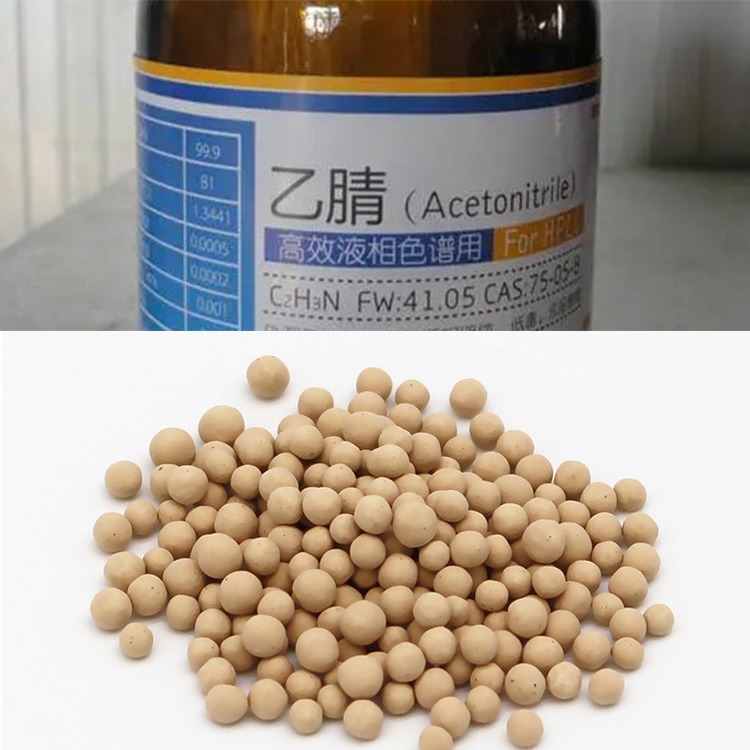A customer reacted 4a molecular sieve with acetonitrile. The specific operation was to remove water from acetonitrile and use it as a UV titration solvent. As a result, when adding 4A molecular sieve (sodium A type) in the first step of treatment, a large number of bubbles emerged and a few were thrown into the water. There are no bubbles in it, so I am not sure whether it is a reaction between acetonitrile and molecular sieve. During use, if bubbles are produced, it proves that it is absorbing water. When it is all placed in water, no bubbles can be seen.
If the activated 4a molecular sieve becomes turbid during the acetonitrile removal process, it can be washed with water first, then put into a muffle furnace for activation before use, so that the turbidity will not be dealt with.

Water removal method for treating acetonitrile with type 4a molecular sieve:
1. Add phosphorus pentoxide and reflux until the phosphorus pentoxide does not turn yellow, then evaporate under nitrogen protection;.
2. Add calcium hydride and reflux for six to eight hours, then evaporate under nitrogen protection;
3. Remove water from the molecular sieve, dry the 4A molecular sieve at about 300° for 6-8 hours, cool it to room temperature under nitrogen protection, add it to acetonitrile under nitrogen protection or let it stand in a dry environment for more than 12 hours.
4. Add 4A type molecular sieve to remove the water in acetonitrile, then add calcium hydride and stir until hydrogen gas is no longer released. In this way, the acetic acid can be removed, leaving only a trace amount of water. Then distill at a high reflux ratio, taking care to prevent moisture from entering. For this purpose, reflux on calcium hydride. You can also add 0.5%-1% phosphorus pentoxide to the distillation flask to remove most of the remaining water. Care should be taken to avoid excessive amounts of phosphorus pentoxide, as it will form an orange polymer.
5. (1) For preliminary water removal, first put acetonitrile into a container, add 4A molecular sieve (dried molecular sieve), seal and leave it for 12 hours.
(2) Distillation. Pour the solution after initial water removal into a round-bottomed flask, add an appropriate amount of phosphorus pentoxide, and a magnetic stirring rotor. Distill until the color of phosphorus pentoxide no longer deepens (usually 5 to 6 hours). Release the solution in the dispenser (use a hair dryer to wash the bottle containing the solution). After that, the bottle containing the solution is sealed and connected to the lower end of the dispenser. Continue heating to distill out the remaining solution, leaving about 100ml. Steam out. Note: The solution should keep boiling throughout the process.
(3) Storage: Add the distilled solution to dry molecular sieves, seal and store away from light.
6. Acetonitrile is infinitely miscible with water and alcohol, and can form a binary azeotrope with water. Its composition and azeotropic point are as follows: Azeotropic point: 77 degrees Celsius (101.33kpa), acetonitrile content 77% (W). Acetonitrile is dehydrated. Since acetonitrile and Water is infinitely soluble in each other, and it is difficult to dehydrate acetonitrile. Acetonitrile and water can form an azeotrope, but the water cannot be separated. For further refining, you can dry it with anhydrous calcium chloride first, then add 0.5-1% five times after filtration. Phosphorus oxide (P2O5) is refluxed and then distilled under normal pressure. Repeat this operation until phosphorus pentoxide (P2O5) is no longer colored, then add newly melted anhydrous potassium carbonate (K2CO3) for distillation to remove trace amounts of phosphorus pentoxide (P2O5).
7. Add phosphorus pentoxide (5-10g/V) to acetonitrile, reflux for 2-3 days, and then steam it out to remove most of the water. Note that a calcium chloride drying tube should be added to the condenser tube during reflux. Excessive addition of phosphorus pentoxide should be avoided as this may result in the formation of orange polymers. Adding a small amount of potassium carbonate to the distilled acetonitrile for further distillation can remove traces of phosphorus pentoxide, and finally use a fractionating column for fractionation. It's very troublesome, but it's relatively pure.
8. First reflux with KMnO4 and K2CO3 for 8 hours, and then steam into a round-bottomed flask containing P2O5. Reflux for another 5 hours and then steam out.